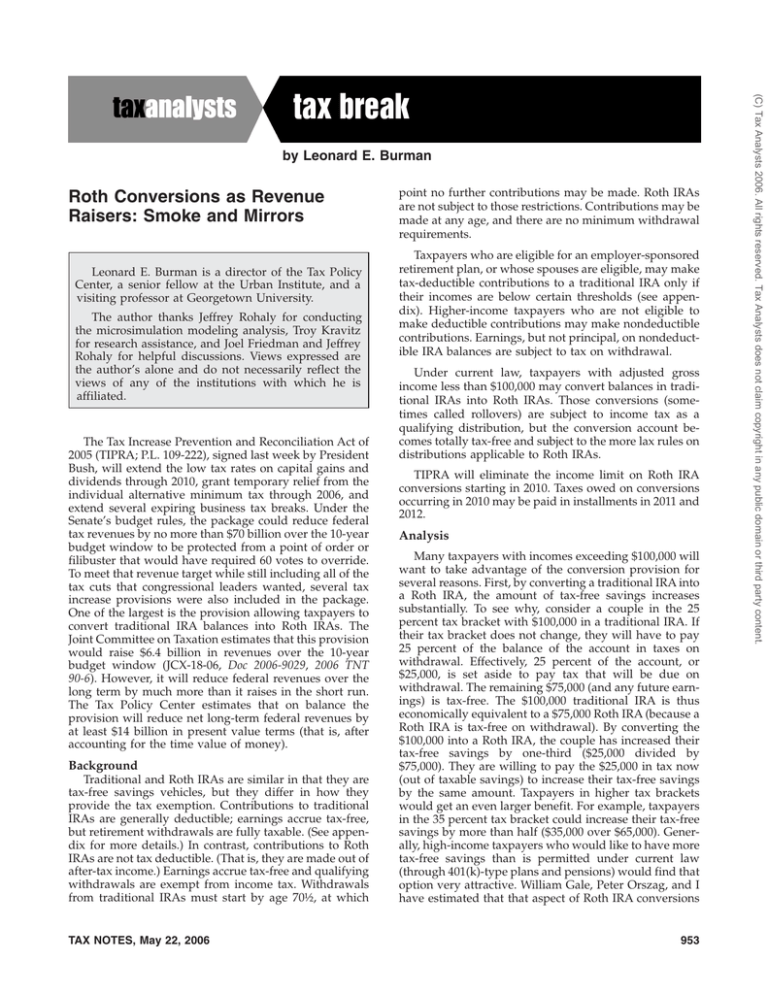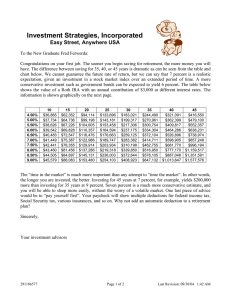Roth Conversions as Revenue
advertisement

Roth Conversions as Revenue Raisers: Smoke and Mirrors Leonard E. Burman is a director of the Tax Policy Center, a senior fellow at the Urban Institute, and a visiting professor at Georgetown University. The author thanks Jeffrey Rohaly for conducting the microsimulation modeling analysis, Troy Kravitz for research assistance, and Joel Friedman and Jeffrey Rohaly for helpful discussions. Views expressed are the author’s alone and do not necessarily reflect the views of any of the institutions with which he is affiliated. The Tax Increase Prevention and Reconciliation Act of 2005 (TIPRA; P.L. 109-222), signed last week by President Bush, will extend the low tax rates on capital gains and dividends through 2010, grant temporary relief from the individual alternative minimum tax through 2006, and extend several expiring business tax breaks. Under the Senate’s budget rules, the package could reduce federal tax revenues by no more than $70 billion over the 10-year budget window to be protected from a point of order or filibuster that would have required 60 votes to override. To meet that revenue target while still including all of the tax cuts that congressional leaders wanted, several tax increase provisions were also included in the package. One of the largest is the provision allowing taxpayers to convert traditional IRA balances into Roth IRAs. The Joint Committee on Taxation estimates that this provision would raise $6.4 billion in revenues over the 10-year budget window (JCX-18-06, Doc 2006-9029, 2006 TNT 90-6). However, it will reduce federal revenues over the long term by much more than it raises in the short run. The Tax Policy Center estimates that on balance the provision will reduce net long-term federal revenues by at least $14 billion in present value terms (that is, after accounting for the time value of money). Background Traditional and Roth IRAs are similar in that they are tax-free savings vehicles, but they differ in how they provide the tax exemption. Contributions to traditional IRAs are generally deductible; earnings accrue tax-free, but retirement withdrawals are fully taxable. (See appendix for more details.) In contrast, contributions to Roth IRAs are not tax deductible. (That is, they are made out of after-tax income.) Earnings accrue tax-free and qualifying withdrawals are exempt from income tax. Withdrawals from traditional IRAs must start by age 70½, at which TAX NOTES, May 22, 2006 point no further contributions may be made. Roth IRAs are not subject to those restrictions. Contributions may be made at any age, and there are no minimum withdrawal requirements. Taxpayers who are eligible for an employer-sponsored retirement plan, or whose spouses are eligible, may make tax-deductible contributions to a traditional IRA only if their incomes are below certain thresholds (see appendix). Higher-income taxpayers who are not eligible to make deductible contributions may make nondeductible contributions. Earnings, but not principal, on nondeductible IRA balances are subject to tax on withdrawal. Under current law, taxpayers with adjusted gross income less than $100,000 may convert balances in traditional IRAs into Roth IRAs. Those conversions (sometimes called rollovers) are subject to income tax as a qualifying distribution, but the conversion account becomes totally tax-free and subject to the more lax rules on distributions applicable to Roth IRAs. TIPRA will eliminate the income limit on Roth IRA conversions starting in 2010. Taxes owed on conversions occurring in 2010 may be paid in installments in 2011 and 2012. Analysis Many taxpayers with incomes exceeding $100,000 will want to take advantage of the conversion provision for several reasons. First, by converting a traditional IRA into a Roth IRA, the amount of tax-free savings increases substantially. To see why, consider a couple in the 25 percent tax bracket with $100,000 in a traditional IRA. If their tax bracket does not change, they will have to pay 25 percent of the balance of the account in taxes on withdrawal. Effectively, 25 percent of the account, or $25,000, is set aside to pay tax that will be due on withdrawal. The remaining $75,000 (and any future earnings) is tax-free. The $100,000 traditional IRA is thus economically equivalent to a $75,000 Roth IRA (because a Roth IRA is tax-free on withdrawal). By converting the $100,000 into a Roth IRA, the couple has increased their tax-free savings by one-third ($25,000 divided by $75,000). They are willing to pay the $25,000 in tax now (out of taxable savings) to increase their tax-free savings by the same amount. Taxpayers in higher tax brackets would get an even larger benefit. For example, taxpayers in the 35 percent tax bracket could increase their tax-free savings by more than half ($35,000 over $65,000). Generally, high-income taxpayers who would like to have more tax-free savings than is permitted under current law (through 401(k)-type plans and pensions) would find that option very attractive. William Gale, Peter Orszag, and I have estimated that that aspect of Roth IRA conversions 953 (C) Tax Analysts 2006. All rights reserved. Tax Analysts does not claim copyright in any public domain or third party content. by Leonard E. Burman COMMENTARY / TAX BREAK 1 See Leonard E. Burman, William G. Gale, and Peter R. Orszag, ‘‘The Administration’s New Tax-Free Saving Proposals: A Preliminary Analysis,’’ Tax Notes, Mar. 3, 2003, p. 1423, available at http://www.taxpolicycenter.org/publications/ template.cfm?PubID=1000469. 2 They can each contribute $4,000 per year in 2006 and 2007 and $5,000 per year in 2008 and 2009. The contribution limits are $1,000 higher if they are age 50 or over. (See appendix.) 3 It is worth noting, however, that taking this additional step would help high-income taxpayers too old to contribute to a traditional IRA since there are no age limits on contributions to Roth IRAs. 954 Short- and Long-Term Effects on Revenues Table 1 illustrates the short- and long-term pattern of tax revenues from the conversion provision. The estimates were calibrated to be roughly consistent with the official 10-year budget estimates produced by the JCT. As intended, the provision will increase federal tax receipts in the budget window, although it loses revenue in the first five years. The estimated $530 billion revenue loss through 2010 arises because some high-income taxpayers elect to transfer savings into nondeductible IRAs. The IRS loses the tax that would otherwise have been paid on the taxable accounts. In calendar years 2011 and 2012, Treasury gains the tax due on all of the rollovers. Thus, from fiscal 2006 to 2015, revenues increase by $6.5 billion. Treasury starts losing revenue in fiscal 2014, however. The losses stem from several sources. First, the taxable withdrawals from the traditional accounts that would have occurred disappear. Second, to the extent that taxpayers cashed in taxable investments to pay the conversion tax in 2011 and 2012, the tax base is reduced for a very long time. The combined effect of those two factors is a revenue loss that grows until many of the taxpayers who make the conversion have died. By our estimates, the revenue loss grows in nominal terms until 2046. In present value, the government loses more than $4 billion because of the conversions from existing IRAs, even though the provision appears to raise $8.6 billion in the budget window. The losses from contributions through nondeductible IRAs are even more substantial. Effectively eliminating the income limits for Roth IRA contributions results in a present value revenue loss of more than $10 billion through 2049 (and more thereafter). The revenue losses will be significantly greater if the high IRA contribution limits, enacted as part of the 2001 tax cut package, are made permanent as the president has proposed. On balance, this ‘‘revenue raiser’’ actually reduces tax revenues by more than $14 billion over the long term. The revenue losses, which grow until 2046, are exceedingly poorly timed. They reduce federal revenues at the same time that the baby boomers are aging, placing significantly greater demands on the federal government. Effectively, the provision will place a large and growing portion of the tax base off limits to tax collectors just when our children and grandchildren will most need tax revenues. Finally, it should be noted that those revenue estimates may turn out to be wildly optimistic. They assume that only a fraction of the assets that could be converted into Roth IRAs actually is converted. Moreover, they don’t account for possible future increases in tax rates. Some proponents of the tax bill point out that budget gimmicks are the norm for both parties. However, this particular gimmick is especially insidious. It will have large and damaging effects on the federal budget for decades to come. (Text continued on p. 956.) TAX NOTES, May 22, 2006 (C) Tax Analysts 2006. All rights reserved. Tax Analysts does not claim copyright in any public domain or third party content. gains the taxpayer (and loses the Treasury) about $1.30 in present value for every dollar converted.1 Second, Roth IRAs have no withdrawal requirements, whereas withdrawals from traditional IRAs must start by age 70½. Thus, taxpayers can allow their money to stay in the Roth IRA much longer, accumulating more tax-free income. That is a very attractive option for taxpayers with sufficient nonretirement wealth that they don’t need to draw on their retirement savings to finance their retirement. Third, performing a conversion allows taxpayers to lock in current tax rates. If tax rates increase in the future (for example, to pay for the growing costs of entitlement programs), Roth IRAs will be exempt from the tax, whereas traditional IRAs will be taxed at prevailing rates. Even if taxpayers do not necessarily expect rates to increase, paying tax now eliminates uncertainty about the taxation of their retirement assets. Fourth, older taxpayers may save on estate tax by converting their IRA balance, because the tax payment reduces the value of the taxable estate. Also, the conversion provision is tantamount to eliminating the income limits on contributions to Roth IRAs for people under age 70½. Currently, taxpayers may not contribute to a Roth IRA if their incomes exceed $160,000 (married filing jointly) or $110,000 (single or head of household). However, they can circumvent those limits by making nondeductible contributions to a traditional IRA and then converting that IRA into a Roth IRA. Moreover, they can start making the maximum allowable contributions in 2006, expecting to convert the account balance in 2010. They would have to pay tax on any earnings in the account, but the converted balance would be a tax-free Roth account from that point forward. A high-income married couple could expect to shelter more than $36,000 in savings that way ($44,000 if they are over age 50).2 After 2010 they can make the maximum contribution to a nondeductible IRA every year and then immediately convert it into a Roth IRA, effectively circumventing the income limits via that convoluted process. Presumably, financial institutions that offer IRAs will try to streamline the process. Another likely outcome is that Congress could decide to eliminate the income limits for Roth IRAs altogether on the grounds that it would be a low-cost simplification measure.3 COMMENTARY / TAX BREAK Conversions of Existing Accounts Calendar Year 2006 2007 2008 2009 2010 2011 2012 2013 2014 2015 2016 2017 2018 2019 2020 2021 2022 2023 2024 2025 2026 2027 2028 2029 2030 2031 2032 2033 2034 2035 2036 2037 2038 2039 2040 2041 2042 2043 2044 2045 2046 2047 2048 2049 2006-2010 2006-2015 2006-2049 Net Present Value TAX NOTES, May 22, 2006 0 0 0 0 0 4,648 4,632 -249 -269 -292 -307 -334 -357 -397 -436 -492 -563 -683 -752 -846 -1,007 -1,129 -1,228 -1,349 -1,464 -1,614 -1,825 -2,015 -2,208 -2,414 -2,592 -2,683 -2,636 -2,811 -2,902 -2,842 -2,914 -2,976 -3,053 -3,196 -3,208 -3,006 -2,872 -2,698 0 8,470 -53,337 -4,314 Revenue Change ($Millions) Contributions Through Nondeductible Accounts Fiscal Calendar Fiscal 0 0 0 0 0 2,324 4,640 2,192 -259 -281 -300 -321 -346 -377 -417 -464 -527 -623 -718 -799 -926 -1,068 -1,179 -1,289 -1,406 -1,539 -1,720 -1,920 -2,111 -2,311 -2,503 -2,637 -2,659 -2,723 -2,856 -2,872 -2,878 -2,945 -3,014 -3,124 -3,202 -3,107 -2,939 -2,785 0 8,616 -51,988 -4,094 0 -64 -131 -200 -270 -155 -182 -417 -460 -511 -565 -619 -673 -732 -782 -838 -900 -964 -1,026 -1,088 -1,148 -1,197 -1,248 -1,311 -1,367 -1,424 -1,465 -1,473 -1,502 -1,535 -1,591 -1,620 -1,651 -1,677 -1,702 -1,719 -1,748 -1,777 -1,779 -1,792 -1,794 -1,680 -1,707 -1,705 -665 -2,391 -48,190 -10,668 0 -32 -97 -166 -235 -213 -168 -299 -439 -486 -538 -592 -646 -702 -757 -810 -869 -932 -995 -1,057 -1,118 -1,172 -1,222 -1,279 -1,339 -1,395 -1,444 -1,469 -1,487 -1,518 -1,563 -1,606 -1,636 -1,664 -1,689 -1,710 -1,734 -1,763 -1,778 -1,786 -1,793 -1,737 -1,694 -1,706 -530 -2,135 -47,337 -10,304 Total Calendar Fiscal 0 0 -64 -32 -131 -97 -200 -166 -270 -235 4,493 2,111 4,451 4,472 -666 1,893 -730 -698 -803 -766 -872 -838 -953 -913 -1,030 -991 -1,130 -1,080 -1,218 -1,174 -1,331 -1,274 -1,463 -1,397 -1,647 -1,555 -1,778 -1,712 -1,934 -1,856 -2,155 -2,044 -2,326 -2,240 -2,476 -2,401 -2,660 -2,568 -2,830 -2,745 -3,039 -2,934 -3,290 -3,164 -3,488 -3,389 -3,710 -3,599 -3,948 -3,829 -4,183 -4,066 -4,303 -4,243 -4,287 -4,295 -4,488 -4,387 -4,604 -4,546 -4,561 -4,583 -4,663 -4,612 -4,753 -4,708 -4,832 -4,792 -4,987 -4,910 -5,003 -4,995 -4,685 -4,844 -4,579 -4,632 -4,403 -4,491 -665 -530 6,080 6,481 -101,526 -99,325 -14,982 -14,398 Very Preliminary 955 (C) Tax Analysts 2006. All rights reserved. Tax Analysts does not claim copyright in any public domain or third party content. Table 1 Short- and Long-Term Revenue Effect From Roth Conversion Provision in 2006 Tax Reconciliation Agreement 2007 to 2049 COMMENTARY / TAX BREAK Assumptions for Table 1: 1. Rate of return on all forms of savings is 6 percent. 2. Traditional IRA would be withdrawn over 15 years starting at age 70. 3. Roth IRA is also held for 15 years from age 70 either by owner or heir. 4. Contributions through nondeductible accounts assume equal contributions start in 2007, the accumulated balance is converted January 1, 2010, and annually thereafter until age 70; calibrated to match roughly JCT estimates through 2015. 5. IRA contribution limits return to $2,000 per year in 2011. If the president’s tax cuts are extended, the revenue loss would be much greater after 2010. 6. Tax rate remains constant over course of life (also tends to understate revenue loss). 7. Table does not show the effect on estate tax receipts (which would be negative). Sources of Revenue Change: 1. Conversions are taxed in 2011 and 2012 (raising revenue in the short run). 2. Money used to pay the tax on conversions comes out of a taxable savings account (losing revenue). 3. Withdrawals from the traditional IRA would be taxable, starting at age 70 (losing revenue). 4. Contributions to nondeductible IRAs come out of taxable accounts (losing revenue). Source: Tax Policy Center Appendix: Summary of IRA Rules There are two types of IRAs: traditional and Roth. Traditional IRAs may also be set up to receive tax-free rollover distributions from another IRA or from an employer plan. Those accounts are sometimes called rollover IRAs. The maximum total annual contribution to all IRAs (not counting rollovers) is the lesser of $4,000 or compensation (wages and salaries plus sole-proprietorship income). The limit increases to $5,000 for individuals age 50 and over. In 2008 the contribution limits will increase to $5,000 ($6,000 for individuals age 50 and over). In 2011, however, the limits revert to $2,000 — the level that applied before the 2001 tax legislation was enacted. Traditional IRA Qualifying individuals under the age of 70½ may make deductible contributions to a traditional IRA. Eligibility for deductible IRA contributions phases out with income for taxpayers with access to an employersponsored plan. In 2006 the phaseout range is from $75,000 to $85,000 for married taxpayers filing joint returns, $50,000 to $60,000 for singles and heads of household, and $0 to $10,000 for married taxpayers filing separately. In 2007 the phaseout range for married taxpayers filing joint returns will increase to $80,000 to $100,000. The phaseout range for a married taxpayer filing a joint return who doesn’t have access to an employer plan and whose spouse is covered by an employer plan is $150,000 to $160,000. Neither the income thresholds nor the maximum contribution amounts are indexed for inflation. Taxpayers who are not eligible for a tax deduction may make nondeductible contributions up to the contribution limits. Withdrawals that correspond to deductible contributions are subject to income tax; withdrawals from nondeductible contributions are taxable only on the earnings in the account (not the original nondeductible contribution). Withdrawals must begin by age 70½; the size of the 956 minimum distribution depends on the taxpayer’s life expectancy (and, in some cases, a beneficiary’s life expectancy). Failure to withdraw the minimum invokes a 50 percent penalty on the difference between the minimum required distribution and the actual distribution. Distributions taken before age 59½ may be subject to a 10 percent penalty. That penalty doesn’t apply in some circumstances, including when the withdrawal is used by unemployed individuals (receiving unemployment compensation for 12 weeks) to pay medical insurance premiums; the withdrawal is used to pay for higher education expenses (including books, fees, and supplies) of a dependent, spouse, or grandchild; or the withdrawal (up to $10,000) is used to buy a first-time primary residence. IRA holders may convert all or part of their balance into an annuity at any age. Annuity payments are generally subject to income tax. Roth IRA The Roth IRA is different from the traditional IRA in several respects, the most important being deductibility rules and the absence of minimum withdrawal requirements. Moreover, there is no age limit for contributions to a Roth IRA, and income limits are different than for a traditional IRA. The maximum contribution to a Roth IRA phases out between $95,000 and $110,000 of AGI for single and head of household returns, between $150,000 and $160,000 for married taxpayers filing joint returns, and between $0 to $10,000 for married taxpayers filing separate returns. Contributions to a Roth IRA are not deductible, but qualified distributions are tax-free. In general, a withdrawal is a qualified distribution if taken at least five years after the initial contribution and the account owner reaches age 59½, is disabled, or spends the proceeds to purchase a primary residence (subject to the same rules that apply to a traditional IRA). Also, withdrawals made by a beneficiary on death are not subject to the penalty. Other withdrawals are subject to a 10 percent penalty. TAX NOTES, May 22, 2006 (C) Tax Analysts 2006. All rights reserved. Tax Analysts does not claim copyright in any public domain or third party content. Table 1 (continued) Short- and Long-Term Revenue Effect From Roth Conversion Provision in 2006 Tax Reconciliation Agreement 2007 to 2049



